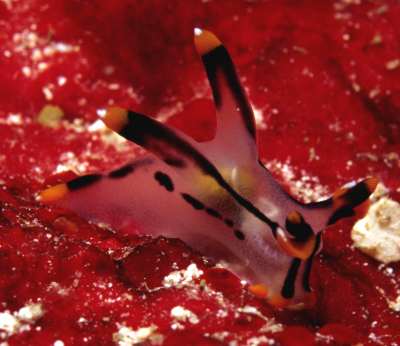Reddish Thecacera picta
January 24, 2006
From: Rokus Groeneveld

Daer Bill,
Today I was checking out some information about Thecacera picta. I noticed they are all more or less white. And because you write in one of your comments not very much is known about the colour variations I send you this picture.
The slug in this case is kind of red. It's not the reflection from the sponge it's on. But is it because it eats it, or an adaptation as camouflage?
Locality: Cabilao Island, Philippines, Visayan Sea. Depth: about 20 meters. Length: about 1 cm. 25 December 2005. wall. Photographer: Rokus Groeneveld
Best regards
Rokus Groeneveld,
Netherlands
rosa12@wxs.nl
Rokus G., 2006 (Jan 24) Reddish Thecacera picta. [Message in] Sea Slug Forum. Australian Museum, Sydney. Available from http://www.seaslugforum.net/find/15590Dear Rokus,
I am pretty sure the red colour is caused by the sponge it is sitting on. These animals are very watery with not much in the way of a thick muscular body wall, so when they don't have any pigment in their skin, we can see through them, very much like we can see shapes and colours through frosted glass. We can see a yellow-brown lump in the middle of the body, which is the digestive gland, and somw whitish bits in front, whcih are parts of the reproductive system and gut. The fact that we can see things inside the body like this shows just how transparent this species is. Since we can't see through it very clearly we say that it is 'translucent clear' rather than transparent. I guess being almost transparent like this is a good simple way to camouflage yourself. Of course not all nudibranchs are translucent or transparent, many such as the chromodorids are hightl coloured.
Best wishes,
Bill Rudman
Related messages
-
Black Thecacera picta from Philippines - 2
From: Marcel Tanke, January 22, 2009 -
Variation of Thecacera picta from Maldives
From: Marcel Tanke, November 25, 2008 -
Black Thecacera from Philippines
From: Marcel Tanke, November 13, 2008 -
Thecacera picta from Philippines
From: Marcel Tanke, August 11, 2008 -
Re: Feeding Thecacera picta from Vanuatu
From: Teresa Zuberbühler, June 6, 2008 -
Thecacera picta from Mozambique
From: Valda Fraser, September 6, 2007 -
Re: Feeding Thecacera picta from Vanuatu
From: Kerem Turker, July 25, 2007 -
Feeding Thecacera picta from Vanuatu
From: Barbara Hanchard, July 9, 2007 -
Re: Thecacera picta from Vanuatu
From: Josh Jensen, April 3, 2007 -
Thecacera picta from Vanuatu
From: Josh Jensen, March 30, 2007 -
Thecacera from Bali
From: Ian Dunsmore, December 31, 2004 -
Thecacera picta from Indonesia
From: Ginette Allard, November 19, 2003 -
Damaged Thecacera picta from Malaysia
From: Asther M. Lau, May 20, 2003 -
Thecacera picta from Vanuatu
From: Vinka Stenhouse, March 4, 2003 -
Re: Thecacera vittata from the Maldives
From: Erwin Koehler, December 7, 2001 -
Thecacera vittata from the Maldives
From: Erwin Koehler, December 6, 2001 -
Re: Thecacera picta - Three's a crowd
From: Mary Jane Adams, December 16, 2000 -
Thecacera picta from the Solomon Ids
From: Bruce Potter, December 15, 2000 -
Thecacera picta from Great Barrier Reef
From: Jim Cruise, July 15, 1999 -
Re: Thecacera picta from Great Barrier Reef
From: Jim Cruise, June 8, 1999 -
Thecacera picta from Great Barrier Reef
From: Jacquie Sheils, May 3, 1999 -
Colour variation in Thecacera picta
From: Clay Bryce, November 13, 1998
